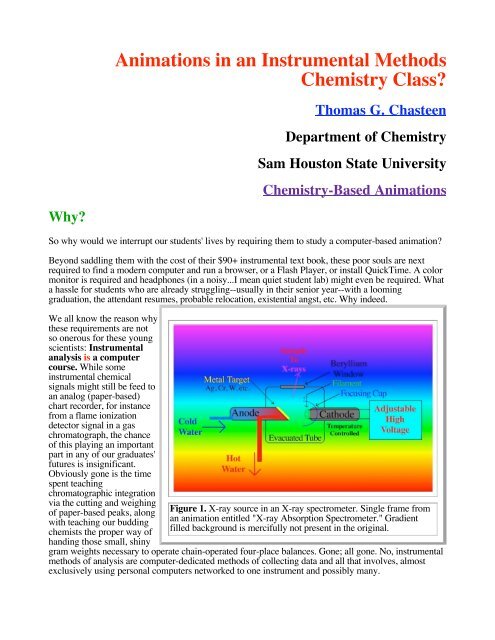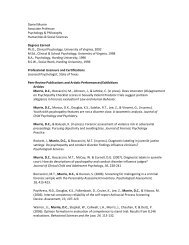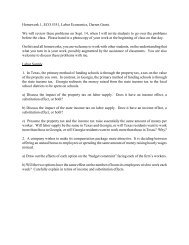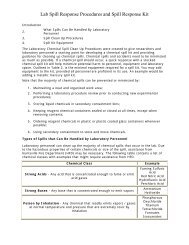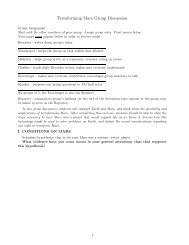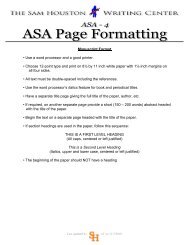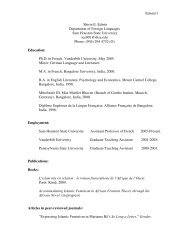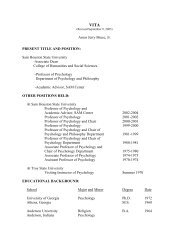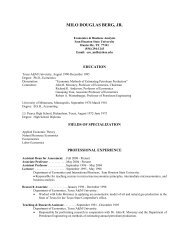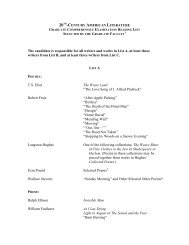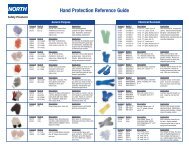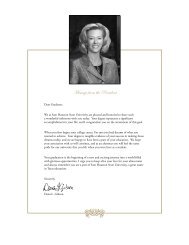Animations in an Instrumental Methods Chemistry Class? (PDF
Animations in an Instrumental Methods Chemistry Class? (PDF
Animations in an Instrumental Methods Chemistry Class? (PDF
Create successful ePaper yourself
Turn your PDF publications into a flip-book with our unique Google optimized e-Paper software.
Why?<br />
<strong>Animations</strong> <strong>in</strong> <strong>an</strong> <strong>Instrumental</strong> <strong>Methods</strong><br />
<strong>Chemistry</strong> <strong>Class</strong>?<br />
Thomas G. Chasteen<br />
Department of <strong>Chemistry</strong><br />
Sam Houston State University<br />
<strong>Chemistry</strong>-Based <strong>Animations</strong><br />
So why would we <strong>in</strong>terrupt our students' lives by requir<strong>in</strong>g them to study a computer-based <strong>an</strong>imation?<br />
Beyond saddl<strong>in</strong>g them with the cost of their $90+ <strong>in</strong>strumental text book, these poor souls are next<br />
required to f<strong>in</strong>d a modern computer <strong>an</strong>d run a browser, or a Flash Player, or <strong>in</strong>stall QuickTime. A color<br />
monitor is required <strong>an</strong>d headphones (<strong>in</strong> a noisy...I me<strong>an</strong> quiet student lab) might even be required. What<br />
a hassle for students who are already struggl<strong>in</strong>g--usually <strong>in</strong> their senior year--with a loom<strong>in</strong>g<br />
graduation, the attend<strong>an</strong>t resumes, probable relocation, existential <strong>an</strong>gst, etc. Why <strong>in</strong>deed.<br />
We all know the reason why<br />
these requirements are not<br />
so onerous for these young<br />
scientists: <strong>Instrumental</strong><br />
<strong>an</strong>alysis is a computer<br />
course. While some<br />
<strong>in</strong>strumental chemical<br />
signals might still be feed to<br />
<strong>an</strong> <strong>an</strong>alog (paper-based)<br />
chart recorder, for <strong>in</strong>st<strong>an</strong>ce<br />
from a flame ionization<br />
detector signal <strong>in</strong> a gas<br />
chromatograph, the ch<strong>an</strong>ce<br />
of this play<strong>in</strong>g <strong>an</strong> import<strong>an</strong>t<br />
part <strong>in</strong> <strong>an</strong>y of our graduates'<br />
futures is <strong>in</strong>signific<strong>an</strong>t.<br />
Obviously gone is the time<br />
spent teach<strong>in</strong>g<br />
chromatographic <strong>in</strong>tegration<br />
via the cutt<strong>in</strong>g <strong>an</strong>d weigh<strong>in</strong>g<br />
of paper-based peaks, along<br />
with teach<strong>in</strong>g our budd<strong>in</strong>g<br />
chemists the proper way of<br />
h<strong>an</strong>d<strong>in</strong>g those small, sh<strong>in</strong>y<br />
Figure 1. X-ray source <strong>in</strong> <strong>an</strong> X-ray spectrometer. S<strong>in</strong>gle frame from<br />
<strong>an</strong> <strong>an</strong>imation entitled "X-ray Absorption Spectrometer." Gradient<br />
filled background is mercifully not present <strong>in</strong> the orig<strong>in</strong>al.<br />
gram weights necessary to operate cha<strong>in</strong>-operated four-place bal<strong>an</strong>ces. Gone; all gone. No, <strong>in</strong>strumental<br />
methods of <strong>an</strong>alysis are computer-dedicated methods of collect<strong>in</strong>g data <strong>an</strong>d all that <strong>in</strong>volves, almost<br />
exclusively us<strong>in</strong>g personal computers networked to one <strong>in</strong>strument <strong>an</strong>d possibly m<strong>an</strong>y.
How?<br />
So once we get over the fear of requir<strong>in</strong>g our students to get as <strong>in</strong>volved as possible with modern<br />
computers <strong>in</strong> their chemistry courses, us<strong>in</strong>g computers to help teach specific topics is a natural<br />
extension. In my senior-level <strong>in</strong>strumental <strong>an</strong>alysis course I use <strong>an</strong>imations <strong>in</strong>side <strong>an</strong>d outside of the<br />
course to teach <strong>in</strong>strumental techniques or particularly import<strong>an</strong>t or conceptually difficult po<strong>in</strong>ts.<br />
The adv<strong>an</strong>tages of us<strong>in</strong>g a schematic movie of the most difficult <strong>in</strong>strumental method I teach, gas<br />
chromatography/mass spectrometry via a Macromedia's Shockwave Flash <strong>an</strong>imation will be briefly<br />
discussed below. But first I'd like to <strong>in</strong>troduce <strong>an</strong> older <strong>an</strong>imation constructed us<strong>in</strong>g a simple draw<strong>in</strong>g<br />
program <strong>an</strong>d Apple's QuickTime . My use of <strong>an</strong>imation vehicles/programs has been morph<strong>in</strong>g as the<br />
program options have ch<strong>an</strong>ged with time. All of the <strong>an</strong>imations I have created to teach with are listed<br />
here <strong>in</strong> roughly chronological order from the bottom of that page (oldest about 1996) upward <strong>in</strong> the list<br />
to the most recent.<br />
In the "early days" the f<strong>in</strong>al file's size was one of the most import<strong>an</strong>t variables <strong>in</strong> each project. The<br />
unavailability of broadb<strong>an</strong>d ethernets <strong>an</strong>d 56 kb modems that are so prevalent today made the <strong>an</strong>imations<br />
files' delivery size very import<strong>an</strong>t then. As our network connections got faster my projects got larger<br />
<strong>an</strong>d larger. As I passed 6 MB <strong>in</strong> file size (the tilted earth <strong>an</strong>imation for <strong>an</strong> atmospheric chemistry class <strong>in</strong><br />
1999 <strong>an</strong>d then a video taped 15 MB (!) freshm<strong>an</strong> titration <strong>in</strong> 2000) I realized that except for my students<br />
access via our on campus T1 l<strong>in</strong>es (300+ kb/sec), fewer <strong>an</strong>d fewer users would wait for a 6 MB file to<br />
download. And this was us<strong>in</strong>g all the shr<strong>in</strong>k<strong>in</strong>g tricks: small palette size (fewer pixels), fewer frames<br />
per second, <strong>an</strong>d extensive compression us<strong>in</strong>g software compressors best suited to the type of images <strong>in</strong><br />
the <strong>an</strong>imation.<br />
Then came Shockwave Flash. The vector-based nature of this program me<strong>an</strong>s that long, complex, full<br />
screen <strong>an</strong>imations are possible at a fraction of the size of bitmapped images. And the MP3 sound<br />
compression even allows for reasonable sound <strong>in</strong>corporation <strong>in</strong> Flash <strong>an</strong>imations, if I could just learn<br />
how to synchronize sound with action....<br />
What?<br />
Example 1: The Double Beam Spectrophotometer<br />
The ideas that I focus <strong>in</strong> on <strong>in</strong> the "Double Beam<br />
Spectrometer Movie " (a screen shot is <strong>in</strong> the<br />
adjacent Figure) <strong>in</strong>volve, for <strong>in</strong>st<strong>an</strong>ce, concepts<br />
that are import<strong>an</strong>t to the <strong>in</strong>strument, e.g., double<br />
beam "functionality," the separation of reference<br />
<strong>an</strong>d sample beams not only <strong>in</strong> space but <strong>in</strong> time<br />
via the beam splitter. The static textbook<br />
draw<strong>in</strong>gs though they be m<strong>an</strong>y <strong>an</strong>d varied often<br />
just haven't been able to get these ideas across to<br />
my students.<br />
In the <strong>an</strong>imation the spectrometer's schematic<br />
parts are <strong>in</strong>troduced one by one along the light<br />
path from source to detector often exclud<strong>in</strong>g<br />
other <strong>in</strong>strumental parts for simplicity (look ma,<br />
no monochromator) . For me this is the ma<strong>in</strong><br />
adv<strong>an</strong>tage of construct<strong>in</strong>g my own <strong>an</strong>imations: I<br />
c<strong>an</strong> build them up frame by frame from the
Figure 2. Frame from <strong>an</strong> <strong>an</strong>imation called<br />
"Double Beam Spectrophotometer."<br />
simple ("this represents a mirror", "this is a beam<br />
splitter") to the more complex <strong>an</strong>d all the user<br />
has to do is move forward <strong>an</strong>d backward <strong>in</strong> the<br />
<strong>an</strong>imation to "disassemble" or "reassemble" the<br />
<strong>in</strong>strument. And I try to "isolate" the parts that<br />
cause the most conceptual trouble for my<br />
students. Examples of the build-up technique c<strong>an</strong><br />
be found <strong>in</strong> these <strong>an</strong>imations: X-ray absorption ,<br />
gas chromatography , GC/MS , flame <strong>an</strong>d<br />
hydride generation atomic absorption<br />
spectrometers for <strong>in</strong>st<strong>an</strong>ce. [All the <strong>in</strong>dividual<br />
<strong>an</strong>imation hyperl<strong>in</strong>ks here <strong>an</strong>d below are to the<br />
Flash versions if available. QuickTime or GIF<br />
<strong>an</strong>imation versions are available at the l<strong>in</strong>k at the<br />
top of the page.]<br />
I have also found it difficult to teach some<br />
students how the signal is generated by a double<br />
beam <strong>in</strong>strument. The "complete" double beam<br />
spectrometer <strong>an</strong>imation provides a mov<strong>in</strong>g<br />
version of the alternat<strong>in</strong>g sample <strong>an</strong>d reference<br />
beams with graphical representations of the<br />
signal produced by the photomultiplier tube<br />
(PMT) as the difference between these signals.<br />
[The adjacent image--not actually <strong>in</strong> the<br />
movie--is false <strong>in</strong> that respect: both beams never fall simult<strong>an</strong>eously on the detector <strong>in</strong> this <strong>in</strong>strument as<br />
displayed]. This is <strong>an</strong>other th<strong>in</strong>g I've decided to <strong>in</strong>corporate <strong>in</strong> my <strong>in</strong>strumental <strong>an</strong>imations: <strong>an</strong> example<br />
of the <strong>in</strong>strument's signal plotted or <strong>in</strong> some way represented as the <strong>in</strong>strument generates that signal<br />
dur<strong>in</strong>g the <strong>an</strong>imation. Examples of these adjacent-data-<strong>in</strong>-the-<strong>an</strong>imation approaches c<strong>an</strong> be found <strong>in</strong> the<br />
Double Beam Spectrometer , Tuneable Monochromator , Flame Ionization Detector , Photoelectric<br />
Effect , GC Cryogenic Focuss<strong>in</strong>g , <strong>an</strong>d the follow<strong>in</strong>g GC/MS <strong>an</strong>imation.<br />
Example #2: Gas Chromatography/Mass Spectrometry<br />
The most complex <strong>in</strong>strumental method I teach <strong>in</strong> my senior <strong>in</strong>strumental <strong>an</strong>alysis course is gas<br />
chromatography/mass spectrometry. There is much <strong>in</strong>volved <strong>in</strong> this method <strong>in</strong> hardware<br />
<strong>in</strong>strumentation, data forms/format, data collection/m<strong>an</strong>ipulation, <strong>an</strong>d <strong>in</strong>terpretation. And yet it has<br />
become so import<strong>an</strong>t <strong>in</strong> modern <strong>in</strong>strumental laboratories that I feel it is <strong>in</strong>cumbent upon me to give<br />
students a very healthy dose of GC/MS while I have fr<strong>an</strong>kly let some more traditional techniques slide<br />
(th<strong>in</strong> layer chromatography, for <strong>in</strong>st<strong>an</strong>ce). Our GC/MS laboratory component encompass three weeks.<br />
When one of my best students a few years ago failed to be able to describe <strong>in</strong> a clear way the differences<br />
between a TIC <strong>an</strong>d <strong>an</strong> MS on a test's essay, I knew I had to do someth<strong>in</strong>g. This of course suggests that I<br />
didn't hold either myself or the student directly responsible, <strong>an</strong>d I didn't; <strong>in</strong>stead it was <strong>an</strong> <strong>in</strong>tellectual<br />
conspiracy of two, along with our textbook!<br />
Orig<strong>in</strong>ally constructed <strong>in</strong><br />
Macromedia's Flash format, this<br />
<strong>an</strong>imation has a number of<br />
programm<strong>in</strong>g features I hadn't<br />
learned about yet <strong>in</strong> my earlier<br />
<strong>an</strong>imations, <strong>an</strong>d therefore they are<br />
simply miss<strong>in</strong>g <strong>in</strong> the earlier<br />
<strong>an</strong>imations. In the case of<br />
navigational buttons--to allow the<br />
user easy movement <strong>in</strong>side the<br />
<strong>an</strong>imation from scene to<br />
scene--this simply was not easily
accomplished <strong>in</strong> my earlier<br />
QuickTime <strong>an</strong>imations. The most<br />
recent versions of QuickTime<br />
allow one to port Flash<br />
<strong>an</strong>imations directly <strong>in</strong>to a<br />
QuickTime file <strong>an</strong>d keep the<br />
navigational buttons <strong>an</strong>d <strong>in</strong>deed<br />
all the Flash features <strong>in</strong> the<br />
QuickTime format.<br />
The adjacent Figure is a snapshot<br />
from the most complex scene <strong>in</strong><br />
the GC/MS <strong>an</strong>imation (the latter<br />
scenes <strong>in</strong> my <strong>an</strong>imations naturally<br />
often show all <strong>in</strong>strumental parts<br />
work<strong>in</strong>g together). Yet this image<br />
also <strong>in</strong>volves all of the most<br />
import<strong>an</strong>t features of a GC/MS<br />
run: ionized fragments stream<strong>in</strong>g<br />
<strong>in</strong>to the mass separator,<br />
fragments be<strong>in</strong>g detected, the total<br />
ion chromatogram (TIC) be<strong>in</strong>g<br />
generated, <strong>an</strong>d <strong>an</strong> earlier sc<strong>an</strong>'s<br />
mass spectrum (MS) be<strong>in</strong>g<br />
Figure 3. Frame from <strong>an</strong> <strong>an</strong>imation entitled "Gas<br />
chromatography/mass spectrometer."<br />
displayed. When students see this on a PC's monitor they are, fr<strong>an</strong>kly, often blown away, not be<strong>in</strong>g able<br />
to underst<strong>an</strong>d what data stems from what process or how the parts <strong>in</strong>tegrate. This <strong>an</strong>imation was my<br />
response to the confusion I saw on my students' faces.<br />
Obviously as the fundamentals of the <strong>in</strong>strument are mastered, <strong>in</strong>troduction <strong>an</strong>d study of more complex<br />
relationships become possible. For example with GC/MS, space/time <strong>in</strong> the course previously dedicated<br />
to gett<strong>in</strong>g the TIC/MS differentiation across c<strong>an</strong> be used to <strong>in</strong>vestigate, for <strong>in</strong>st<strong>an</strong>ce, more complex<br />
fragmentation patterns, formation of metastable peaks, or the benefits of different ionization methods. In<br />
atomic absorption spectrometry (AAS ), facile underst<strong>an</strong>d<strong>in</strong>g of the fundamental relationships between<br />
light absorption <strong>an</strong>d a l<strong>in</strong>ear signal generation, frees us, for <strong>in</strong>st<strong>an</strong>ce, to study the benefits of hydride<br />
generation atomic absorption spectrometry or graphite furnace AAS.<br />
When <strong>an</strong>d Where?<br />
These <strong>an</strong>imations are often <strong>in</strong>troduced <strong>in</strong> my class us<strong>in</strong>g a computer-feed projector. In that venue, lots of<br />
starts <strong>an</strong>d stops, forwards <strong>an</strong>d backwards, <strong>an</strong>d judicious pauses of the <strong>an</strong>imation are used to teach the<br />
material <strong>an</strong>d as a group we parse out the the functions of all the <strong>in</strong>strument's parts. If there is sound I<br />
almost always turn that off!<br />
S<strong>in</strong>ce the files are also available on the web (<strong>an</strong>d actually gett<strong>in</strong>g smaller as time goes on us<strong>in</strong>g<br />
vector-based programm<strong>in</strong>g), the students are also encouraged to <strong>in</strong>vestigate the <strong>an</strong>imations out of class.<br />
If the situation is appropriate, <strong>an</strong>imations are sometimes used dur<strong>in</strong>g tests--(often stripped of the<br />
<strong>in</strong>strumental labels)--with essay-based questions about component relationships or functions.<br />
Conclusions<br />
I have f<strong>in</strong>ally been able to comfortably approach concepts <strong>in</strong> a senior level <strong>in</strong>strumental <strong>an</strong>alysis course<br />
us<strong>in</strong>g <strong>an</strong>imations, teach<strong>in</strong>g that didn't "go" so well before.<br />
Like most of our efforts to improve our teach<strong>in</strong>g I have as "proof" of this teach<strong>in</strong>g technique's success
only a feel<strong>in</strong>g about my students, a feel<strong>in</strong>g of their more complete underst<strong>an</strong>d<strong>in</strong>g of these complex<br />
<strong>in</strong>struments. It's k<strong>in</strong>d of like the opposite of what I feel like when one of my better students, on the<br />
third test of the semester, completely misunderst<strong>an</strong>ds a newly worded complex question. Well if she<br />
doesn't get it, you c<strong>an</strong> bet the more average student won't <strong>an</strong>d as you grade the rest of the test set that<br />
<strong>in</strong>itial hypothesis is born out. Sometimes I just throw out the question altogether.<br />
With these <strong>an</strong>imations, I feel that my test<strong>in</strong>g is more thorough <strong>an</strong>d my <strong>in</strong>tellectual dem<strong>an</strong>ds more<br />
rigorous. Everyone <strong>in</strong> the class seems to do better with these k<strong>in</strong>ds of tools, the teacher <strong>an</strong>d the students.<br />
Return to Newsletter Chasteen's Home Page Department of <strong>Chemistry</strong> Sam Houston State<br />
University


